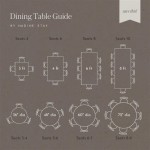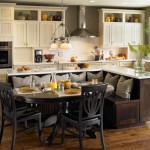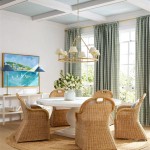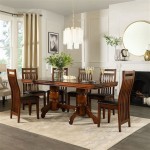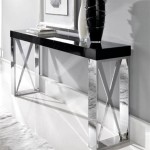Ideas For Sewing Machine Tables
A dedicated sewing machine table provides a stable and ergonomic workspace, dramatically improving the sewing experience. Instead of balancing a machine on a kitchen table or desk, a well-designed sewing table offers features tailored to the specific needs of sewing projects, such as adjustable height, storage compartments, and a flush sewing surface. The options for crafting a suitable sewing machine table are varied, ranging from repurposed furniture to custom-built designs.
Repurposing Existing Furniture
One cost-effective approach to creating a sewing machine table involves repurposing existing furniture. A sturdy desk, a vintage writing table, or even a well-built console table can be adapted to accommodate a sewing machine. Before beginning any modifications, it is crucial to assess the furniture's dimensions and structural integrity. The table’s surface area should be large enough to comfortably hold the sewing machine and provide ample space for fabric manipulation. The height should also promote good posture, generally around 29-30 inches for most individuals. Adjustments may be necessary to achieve the ideal height, such as adding leg extensions or trimming the legs if the furniture is too tall.
The primary modification often required for repurposed furniture is creating a recessed platform for the sewing machine. This allows the sewing machine bed to sit flush with the table surface, providing a seamless sewing experience and preventing fabric from snagging. This can be accomplished by carefully measuring the dimensions of the sewing machine base and then cutting a corresponding opening in the table's surface. A jigsaw or router is commonly used for this task, and it is important to ensure smooth, clean edges to prevent splintering and ensure a professional finish. Alternatively, a smaller platform can be constructed from wood and attached to the underside of the table to support the sewing machine at the desired height. This method avoids cutting into the existing table surface, which may be preferable for antique or valuable pieces.
Storage is another key consideration when repurposing furniture for sewing. Drawers can be used to store thread, bobbins, scissors, and other small sewing supplies. Shelves can accommodate larger items such as fabric bolts, patterns, and cutting mats. If the repurposed furniture lacks adequate storage, consider adding storage containers or shelves underneath or alongside the table. Rolling carts can be a versatile addition, providing accessible storage while also being easily moved around the workspace.
Custom-Built Sewing Machine Tables
For those with woodworking skills or a desire for a highly customized solution, building a sewing machine table from scratch offers maximum flexibility. This approach allows for tailoring the table's dimensions, features, and aesthetics to perfectly match individual needs and preferences. Plans for sewing machine tables are readily available online, ranging from simple designs suitable for beginners to more complex models that incorporate specialized features.
The selection of materials is a crucial aspect of custom-built sewing machine tables. Solid wood, plywood, and MDF (medium-density fiberboard) are popular choices, each offering its own advantages and disadvantages. Solid wood provides durability and aesthetic appeal but can be more expensive and require more specialized woodworking tools. Plywood offers a good balance of strength, affordability, and workability. MDF is a cost-effective option that is easy to cut and paint but may not be as durable as solid wood or plywood. Consider the intended use and aesthetic preferences when selecting the appropriate material.
A critical design element for custom-built sewing machine tables is the inclusion of a recessed platform for the sewing machine. As with repurposed furniture, this allows the sewing machine bed to sit flush with the table surface. When designing the recessed platform, precise measurements of the sewing machine's base are essential. The opening should be slightly larger than the machine's base to allow for easy removal and placement. The platform can be constructed from wood or metal and should be securely attached to the table frame to provide stable support for the sewing machine.
Additional features that can be incorporated into custom-built sewing machine tables include adjustable height mechanisms, drop-leaf extensions, and integrated lighting. Adjustable height mechanisms allow the table's height to be adjusted to accommodate different sewing tasks and user preferences. Drop-leaf extensions provide additional workspace when needed and can be folded down when not in use. Integrated lighting illuminates the sewing area, improving visibility and reducing eye strain. These features can significantly enhance the functionality and comfort of the sewing machine table.
Specialized Sewing Machine Table Features
Beyond the basic requirements of a stable surface and a flush sewing area, several specialized features can significantly enhance the functionality of a sewing machine table. These features are often incorporated into commercially available sewing machine tables but can also be added to repurposed or custom-built designs.
One such feature is a lift mechanism. Lift mechanisms allow the sewing machine to be easily raised or lowered, providing flexibility for different sewing tasks. When lowered, the sewing machine can be stored flush with the table surface, creating a level workspace for cutting or other projects. When raised, the sewing machine is ready for sewing. Lift mechanisms are available in various types, including manual, pneumatic, and electric options. The choice of lift mechanism depends on the budget, desired level of automation, and the weight of the sewing machine.
Another valuable feature is a built-in thread stand. A thread stand provides a convenient and organized way to store and dispense multiple spools of thread. It typically consists of a series of vertical pegs or spindles that hold the thread spools, allowing for easy access and preventing tangling. Thread stands can be particularly useful for projects that require frequent color changes or for serging, which often requires multiple spools of thread. Thread stands can be purchased separately or built into the sewing machine table design.
An often-overlooked but highly beneficial feature is proper cable management. Sewing machines and related accessories often have power cords and foot pedal cables that can become tangled and create clutter. Incorporating cable management solutions into the sewing machine table design can help to keep the workspace organized and prevent tripping hazards. Cable trays, ties, and sleeves can be used to route and secure cables, keeping them out of the way and creating a cleaner, more efficient workspace.
Finally, consider the surface finish of the sewing machine table. A smooth, durable finish is essential for preventing fabric from snagging and making it easier to clean up spills. Laminate and polyurethane finishes are popular choices for sewing machine tables. Laminate is a cost-effective option that provides a durable and easy-to-clean surface. Polyurethane is a more durable and water-resistant option that provides a smooth, even finish. The choice of finish depends on the budget, desired level of durability, and aesthetic preferences.
When considering the features of a sewing machine table, it is important to assess individual sewing habits and project requirements. Different sewing tasks may benefit from different features. For example, a quilter may prioritize a large, flat surface area, while a garment sewer may prioritize storage for patterns and fabric scraps. By carefully considering these factors, a sewing machine table can be designed or adapted to perfectly meet individual needs and enhance the sewing experience.

The Best Diy Sewing Table Ideas For Any Space Elizabeth Made This

20 Inspiring Diy Sewing Table Ideas In 2024

9 Sewing Tables For Your Machine Heather Handmade

10 Small Sewing Table Options For Space Squeezed Sewists Sie Macht

Old Sewing Table Idea Turn It Into A Bevarage Station

Craft Table Idea Reinvented Delaware

5 Dainty Sewing Table Ideas You Must Have

Sewing Table Gift Room Design Quilting Diy

Diy Sink Your Own Sewing Machine Save Money Quilting

How To Repurpose A Sewing Machine Table Girl In The Garage

